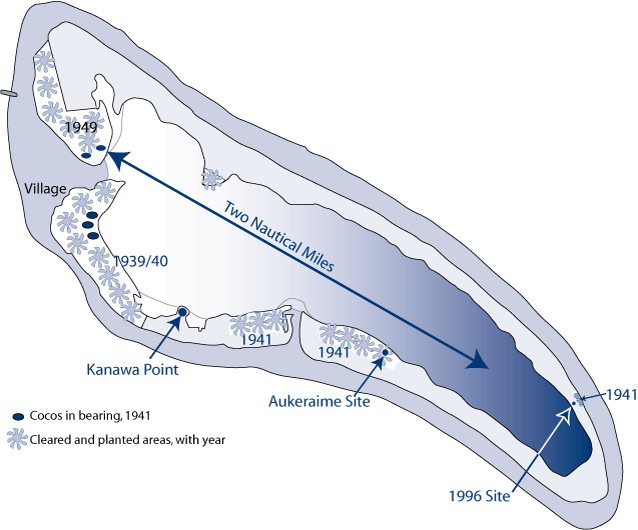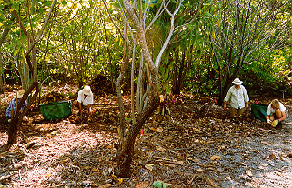 |
|
|
|
|
|
|
|
|
|
|
|
||
|
|
|
||
pp. 42 – 50
| Gallagher’s Clues |
|
Whether or not there were bones found other than the partial skeleton collected by Gerald Gallagher is still a matter of debate. What is not in dispute is that the young Colonial Service officer found human remains that possibly, even probably, were those of Amelia Earhart. If we can pinpoint where on the island Gallagher’s discovery was made we can conduct a thorough search and perhaps find more material. But that is easier said than done.
As far as we know, Gallagher never marked a map or provided a detailed description of exactly where he found the bones. Instead, he made passing references in various correspondence from which we must assemble our treasure map.
“Ren” refers to Tournefortia argentia, a smallish tree that now grows pretty much all over the island, so that’s not much help. Birds, likewise, are not unique to any one part of the atoll but their principle nesting grounds tend to be along the northern and southern shore (see map). We’ve seen turtle tracks most often on the ocean beach along the northern shore but also occasionally on the southern shore.
Whether or not the scattering was actually done by coconut crabs, Gallagher obviously thought that there were crabs in the area. Birgus latro much prefers the shady forests to the harsher, more open parts of the island –- but then, logically, so would a castaway.
From aerial photos and official reports we have good information about what parts of the island were cleared and planted, and when (see map).
This would seem to be another indication that the site was in a shady forest area.
Clearly, the area in question was scheduled to be planted. Whether those plans were ever carried out is another question.
This would seem to place the site quite definitely near the lagoon shore.
This could be a pretty good clue, depending upon how literally we want to take Gallagher’s estimate of distance. In 1941 there were five groves of mature coconut trees on the island (see map).

|
Kanawa Point |
|
| Pro: | Kanawa (Cordia subcordata) is a rare and valuable hardwood that once grew on Nikumaroro but is apparently now extinct, having been harvested out early in the colonial period. The specific mention of a kanawa tree growing on the lagoon shore close to the castaway’s campsite (No. 9 above) raises the suspicion that the site was on the one place on the island where we know that kanawa trees once grew in abundance. A small peninsula along the atoll’s southern shoreline appears as “Kanawa Point” on the map made by the 1938/39 New Zealand survey party for that reason. It was also said to be the scene of a strange encounter by the wife of the island’s first Native Magistrate, Teng Koata, with the atoll’s guardian spirit Nei Manganibuka (see “Kanawa Point” in TIGHAR Tracks Vol. 14, Nos. 1&2). |
| Con: | By no stretch of the imagination is Kanawa Point on the south east corner (Point 2 above) or the south east shore of Nikumaroro (Point 6 above). Also, Kanawa Point was never planted to coconuts (see Point 8 above) and is within one mile, not two, of the nearest stand of coconut trees that were present in 1941 (see Point 10 above). |
| Summary: | Favoring Kanawa Point: Points 5, 9. Against Kanawa Point: Points 2, 6, 8, 10. |
| Assessment: | TIGHAR has found no artifacts on Kanawa Point but neither have we conducted any kind of real search there. Although it was probably once open and quite pleasant, it is now thickly overgrown with dense scaevola underbrush. An organized inspection of Kanawa Point would be a labor intensive and time consuming enterprise. With so little going for it, a search of Kanawa Point now seems to be a low priority. |
| The Aukeraime Site | |
| Pro: | This is the location where, in 1991, TIGHAR found the heel, fragmented sole, and one brass shoelace eyelet from what appears to have been a shoe identical in type, vintage, and size to those worn by Earhart on her final flight. Nearby was the heel from a different pair of shoes. Given that Gallagher also found the partial sole of a “woman’s stoutish walking shoe” and some portion of a man’s shoe, this would seem to be a strong indication that we’re in the right neighborhood. The place where we found the shoe parts is near the lagoon shore and it is certainly possible that a kanawa tree once grew there (Point 9). Our find was made a bit more than 100 feet above the usual high tide line; however, it’s also clear that we found shoes that Gallagher didn’t find, so the site of his discovery could be a bit closer to the lagoon (Point 1). The Aukeraime site is on the southeastern part of the island (Point 6) and we know that the area was cleared for planting by June of 1941 (Point 8). The nearest stand of cocos in 1941 was just under two miles away (Point 10). |
| Con: | Although on the southeastern shore, the Aukeraime site is nowhere near the southeast “corner” of the island (Point 2). Another more speculative argument against this site is that the width of the land mass between lagoon shore and ocean beach is about 400 meters and, presuming that the turtle was caught on the ocean beach, it is difficult to imagine a castaway dragging a several hundred pound turtle that far (Point 3). |
| Summary: | Favoring
the Aukeraime Site: Points 1, 6, 8, 9, 10.
Against the Aukeraime Site: Points 2, 3. |
| Assessment: | Because
the Aukeraime Site has appeared to be so promising as the place where the
bones may have been originally found, TIGHAR devoted a considerable amount
of time to detailed searches of the area during Niku II in 1991 and Niku
III in 1997. Results have been disappointing. Aside from the shoe parts
found in 1991, the only object of interest was a partially burned fragment
of a paper can label found in the ashes and charcoal of a small fire uncovered
in 1997. Subsequent analysis of the fragment has reliably dated it to relatively
modern times and we now suspect that it, and the fire it was in, may be
from a 1978 survey of the island by Kiribati authorities. A further examination
of the Aukeraime Site would mean expanding the search area into the surrounding
coconut jungle–a difficult prospect given the carpet of fallen nuts, some
rotted, some rooted, which covers much of the ground.
Work in progress at the Aukaraime Site, 1997. TIGHAR photo by P. Thrasher. |
| Continued; click here for remainder of article. | |
Back to Archive List

